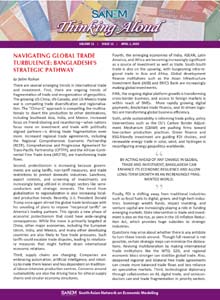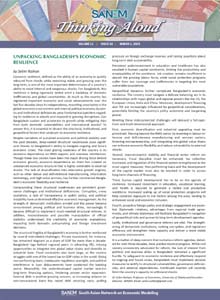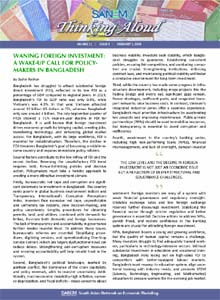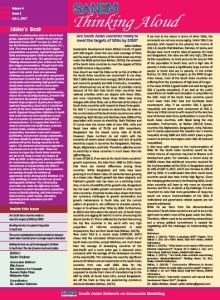
Thinking Aloud: Volume IV, Issue 2
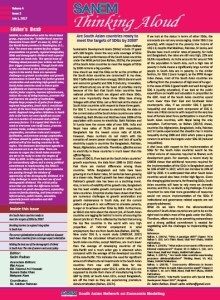 SANEM, in collaboration with the World Bank group, organized the “SANEM-North America Discussion Forum 2017ʺ on June 12, 2017, at the World Bank premises in Washington, D.C., USA. The event was marked by four trigger presentations on growth, regional integration, SDGs and demographic dividend with especial emphasis on South Asia. This special issue of Thinking Aloud presents four articles on those four trigger presentations. These articles are written by Dr. Selim Raihan (Executive Director, SANEM), Dr. Martin Rama (Chief Economist for the South Asia region of the World Bank), Dr. Robert Beyer (Economist, World Bank), and Dr. Ipshita Pal (Postdoctoral Research Fellow, Columbia University).
SANEM, in collaboration with the World Bank group, organized the “SANEM-North America Discussion Forum 2017ʺ on June 12, 2017, at the World Bank premises in Washington, D.C., USA. The event was marked by four trigger presentations on growth, regional integration, SDGs and demographic dividend with especial emphasis on South Asia. This special issue of Thinking Aloud presents four articles on those four trigger presentations. These articles are written by Dr. Selim Raihan (Executive Director, SANEM), Dr. Martin Rama (Chief Economist for the South Asia region of the World Bank), Dr. Robert Beyer (Economist, World Bank), and Dr. Ipshita Pal (Postdoctoral Research Fellow, Columbia University).
Though South Asia is now considered as the fastest growing region in the world, there are numerous challenges to growth acceleration and growth maintenance in South Asia. For further growth acceleration and sustaining high growth rates, South Asian countries need to invest quite significantly on improvement in human capital, foster exports, improve infrastructure, reduce the cost of doing business, promote FDI and improve the quality of institutions.
Despite large prospects of gains from deeper regional integration, South Asia is considered as one of the least integrated regions in the world. Regional http://www.aipa.com.au/cialis-online/ integration initiatives in South Asia so far have not seen significant success due to a number of economic and political economy factors. It is argued that there is a need to overcome non-tariff issues, promote services trade, enhance investment cooperation, smoothen trade and transport facilitation, and promote energy cooperation. All these should be guided strongly by the political will of the leading countries in the region.
The dominant development agenda in the present era is on the SDGs. There are reasons to argue that South Asian countries are yet to be ready to meet the targets of SDGs by 2030. In this regard, there is a need for extraordinary efforts and a strong political commitment to implementing the SDGs in South Asia. Most of the South Asian countries are passing through the window of opportunity of the demographic dividend. It is a big challenge to make the best use of such demographic dividend. The critical policy areas that can make the difference include investment on youth development, expanding access to family planning, and investment in infrastructure, public health, education, especially female education and skill development.
Tag: South Asia, SDGs, growth acceleration

